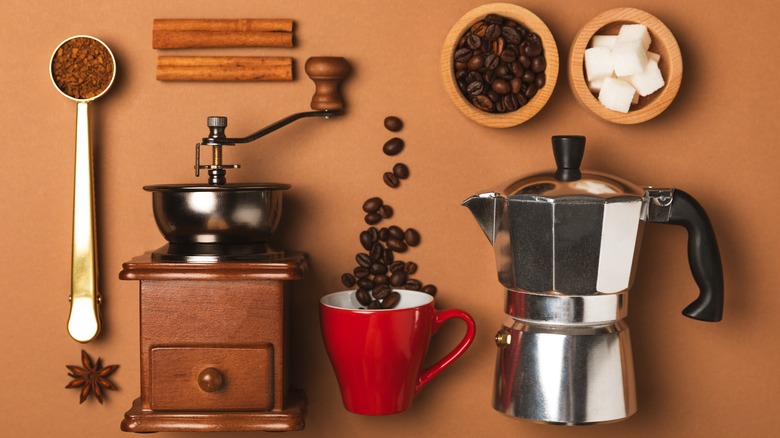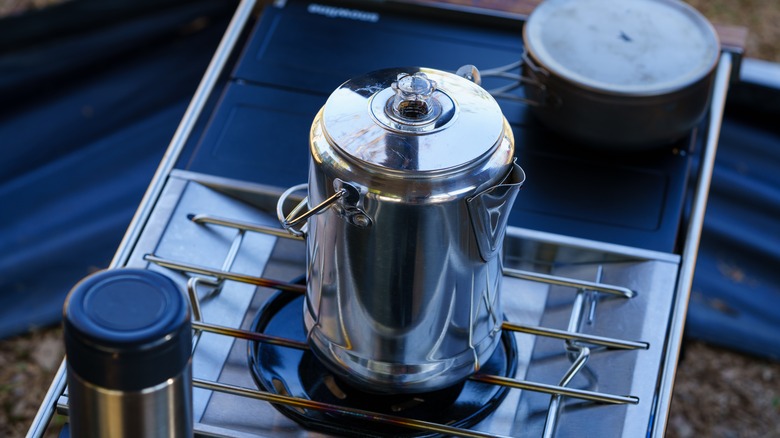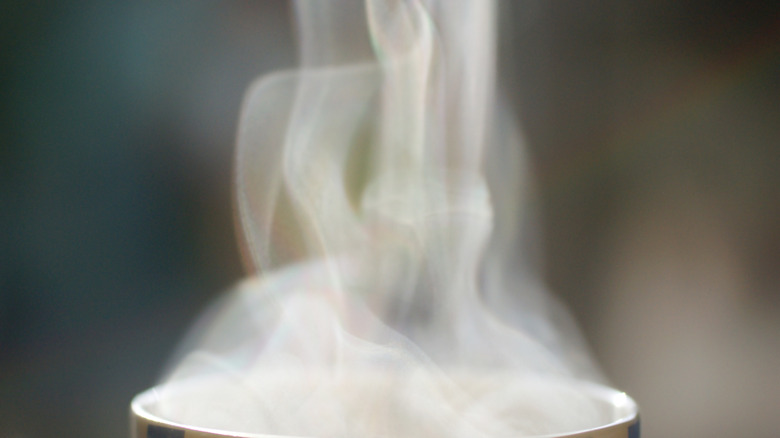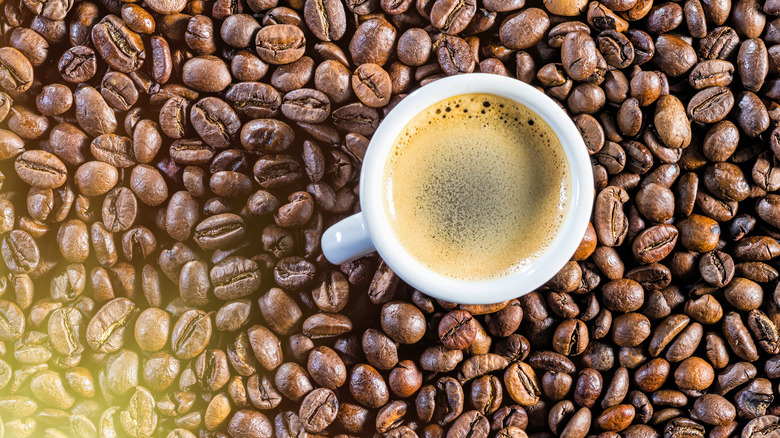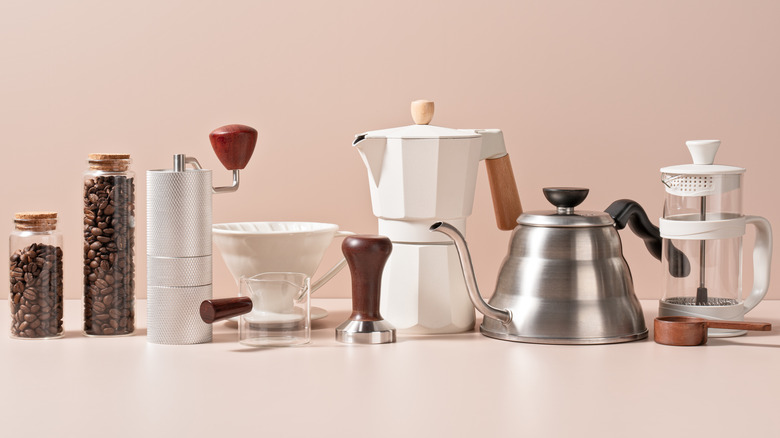What's The Distinction Between A Coffee Percolator And Moka Pot?
Coffee is an iconic beverage with a long and storied history. Originating in Ethiopia around 850 C.E., coffee quickly made its way from Africa to the Mediterranean, and then on to Europe and the rest of the world. Today, making and drinking coffee is practically its own subculture, with a staggering array of coffee-based beverages to choose from and gadgets with which to make them. From the classic handmade cappuccino to the vintage percolator, there's a caffeine-fueled drink fit for every taste.
Though drip coffee is common in modern times, percolators and moka pots were the preferred methods of yesteryear. Considered vintage today, these self-contained brewing systems used to be the hallmark of modern kitchens in the late 19th and early 20th century. Both gadgets made it easy to brew a good cup of coffee at home, with percolators in particular making a 21st century comeback. Of course, the burning question here is: which makes better coffee? To answer that, you'll need to understand how each of these brewers work and what kind of coffee they produce.
What is a moka pot?
The moka pot was invented in 1933 by Alfonso Bialetti, an Italian engineer. Prior to this, the most common brewing device in the country was the Napoletana, a two-chambered home brewing system similar to the moka pot. Both systems have two chambers, but the Napoletana needed to be flipped over to complete the brewing process, which was cumbersome.
To solve this issue, Bialetti drew inspiration from the way his wife steamed their clothes. After hanging the clothes, she used a lid with a tube poking out of the center of it to cover her laundry tub full of hot water. The tube funneled the steam up into the clothes to eradicate wrinkles. Bialetti modified this design to create a two-chambered coffee brewer that didn't need to be flipped.
The design featured a lower chamber that held water, with a fine mesh basket for ground coffee suspended above it. A metal disc with a tube in the center separated the top and bottom chambers. As the water in the bottom chamber came to a boil, steam rose up through the fine mesh basket to brew the coffee. Continued pressure from heating then forced the coffee through the tube above the grounds, until it spilled out into the top chamber to make a rich, dark brew similar to espresso.
What is a percolator?
Though we can thank American physicist Benjamin Thompson for crafting the first percolator in the early 1800s, he failed to patent his design. In fact, that wouldn't happen until nearly 80 years later when farmer and photographer Hanson Goodrich patented the percolator design we're familiar with today. This invention was inspired by a need for an all-in-one coffee brewing system that was less finicky than the pour-over methods used prior.
Pour-over methods in the last decades of the 18th century involved placing grounds in a paper filter or strainer and patiently pouring hot water over them. This method was time-consuming, and didn't produce consistent results. The percolator, on the other hand, allowed those making coffee at home to simply add grounds and water to it and set it over a fire or on the stove to brew.
Inside a percolator, the grounds are suspended above the water on a perforated plate with a small tube in the center of it. As the water heats, it's forced up through the tube and spills out onto the grounds. The water filters through the grounds and drips back into the bottom chamber. This cycle repeats until the percolator is removed from the heat, allowing home brewers to control the strength and taste of their coffee.
Brewing methods — steam vs gravity
The percolator and the moka pot use similar mechanisms to achieve different results. Both coffee makers feature a metal filter to hold the grounds, and a tube that transports liquid from one area of the brewer to another. The main differences between them include how often the water passes through the grounds and where the coffee ends up when the process is finished.
In a moka pot, steam is forced up through a fine mesh basket, and a tube above the basket carries the brewed coffee into an upper chamber that's sealed off from the hot water and grounds. This means the water only has one opportunity to extract color and flavor from the beans. However, since the water rises as steam, the grounds become fully saturated and release a fairly strong cup of coffee.
The percolator, on the other hand, allows the water to pass through the grounds multiple times. It has one chamber instead of two, and the brewed coffee ends up below the used grounds. Rather than carrying the coffee into a separate chamber, the tube in a percolator carries water to the grounds. Instead of steam, hot water washes through the coffee, and drips back down to mix with the rest of the water. Since the coffee is continuously diluted by this process, pouring from the percolator too soon can yield a weak cup of joe.
Flavor profile — which brew tastes best?
What makes a truly delicious cup of coffee is the subject of much debate. Some people believe bold, strong, dark roasts are the only way to go, while others prefer a lighter roast with a sweeter flavor. Whether you prefer moka pot or percolator coffee is largely a matter of personal preference — you may even enjoy both on different occasions.
Since the coffee grounds in a moka pot are saturated with steam, it tends to produce a darker, richer, more concentrated brew similar to espresso. However, moka pots also have a reputation for brewing bitter coffee if you aren't careful. The key to getting the perfect brew from your moka pot involves using the right kind of water and coarse-ground coffee.
If you're a drip coffee purist, a percolator may be more your style. Percolators make coffee similar to classic drip brews, but often with a stronger, more robust flavor. Since the water passes through the grounds several times, percolators can be prone to producing over-brewed coffee. To prevent this, keep a close eye on your percolator and remove it from the heat when the coffee reaches your preferred strength.
Ease of use — which method is simpler?
Making coffee with either a percolator or a moka pot is relatively straightforward — add water and coffee, close, and heat. However, both brewers can be a little confusing when using them for the first time. It might be best to try them both out to see which one is easier for you to use.
When you open a percolator, you'll see a central tube with two perforated plates or baskets attached. Remove it, add your water, and replace the central tube. Line the lower perforated plate or basket with a paper percolator filter, then add your coffee grounds on top of the liner. The upper plate or basket requires no liner, as it's there to help the water drip onto the grounds evenly. Close the percolator and place it on the stove, watching the clear glass bulb on the top of the lid to see when the coffee becomes the color of your preferred brew strength.
A moka pot consists of two octagonal chambers that screw apart. The lower chamber contains a fine mesh basket and has a steam valve to prevent pressure buildup. Remove the mesh basket and add hot water to the lower chamber until the water line is right below the steam valve. Place the basket over the water and fill it with coffee grounds. Then, screw the top and bottom chambers together and heat the moka pot on the stovetop until the upper chamber is full of delicious coffee.

